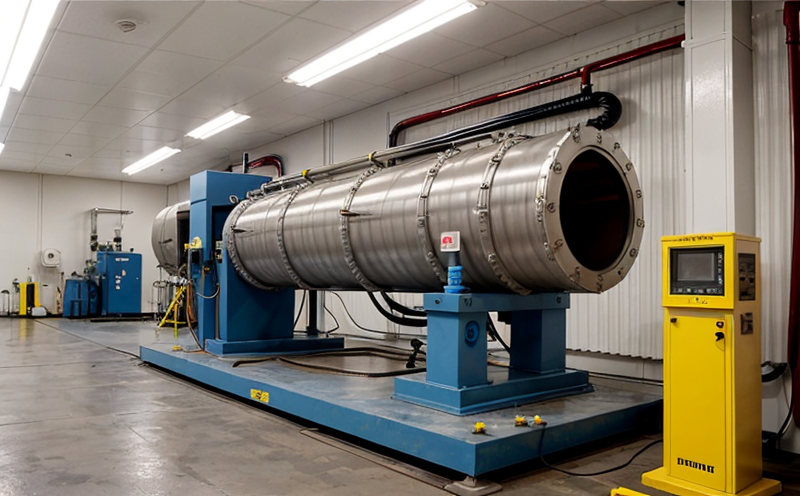ISO 16589 Characterization of Thorium Fuel Materials
The ISO 16589 standard provides a comprehensive framework for characterizing thorium fuel materials used in nuclear reactors. This service is designed to ensure the quality, safety, and performance of thorium-based fuel assemblies by providing detailed analysis of their physical properties, chemical composition, and structural integrity.
Thorium, as a fertile material, plays a crucial role in the nuclear industry due to its ability to produce fissile isotopes through neutron capture. The characterization process outlined in ISO 16589 is essential for ensuring that thorium fuel materials meet stringent quality requirements set by regulatory bodies and industry standards.
The testing protocol involves multiple stages, including sample preparation, irradiation, post-irradiation examination (PIE), and various analytical techniques. The service includes the following key steps:
- Sample Preparation: Thorium fuel samples are prepared according to ISO 16589 guidelines to ensure that they are representative of the intended fuel assemblies.
- Irradiation: Samples are subjected to neutron irradiation in a nuclear reactor facility, simulating the conditions they will encounter during their operational life.
- Post-Irradiation Examination (PIE): After irradiation, samples undergo detailed examination using advanced techniques such as radiography, scanning electron microscopy (SEM), and energy-dispersive X-ray spectroscopy (EDX).
- Analytical Techniques: A range of analytical methods are employed to evaluate the physical properties and chemical composition of thorium fuel materials. These include calorimetry, thermal analysis, and neutron activation analysis.
The characterization process aims to provide detailed insights into the microstructure, mechanical properties, and chemical behavior of thorium fuel materials under operational conditions. This information is vital for optimizing reactor performance, enhancing safety margins, and ensuring compliance with international standards.
By adhering to ISO 16589, laboratories can ensure that their testing results are reliable, repeatable, and comparable with those from other accredited laboratories worldwide. The service offers a robust framework for characterizing thorium fuel materials, supporting the development of advanced nuclear fuels and ensuring safe and efficient reactor operations.
Scope and Methodology
| Test Parameters | Description |
|---|---|
| Sample Preparation | The process involves grinding, sieving, and conditioning the samples to ensure consistency. |
| Irradiation Conditions | Samples are exposed to a neutron flux in a nuclear reactor for specified durations. |
| Post-Irradiation Examination (PIE) | Involves non-destructive and destructive examination techniques to assess changes in microstructure, mechanical properties, and chemical composition. |
| Analytical Techniques | Includes calorimetry, thermal analysis, neutron activation analysis, SEM, and EDX. |
The scope of the ISO 16589 Characterization service encompasses a wide range of test parameters, including physical properties, chemical composition, and structural integrity. The methodology ensures that thorium fuel materials meet stringent quality requirements set by regulatory bodies and industry standards.
By following this comprehensive approach, laboratories can provide reliable and repeatable results, ensuring the safe and efficient operation of nuclear reactors. The service supports the development of advanced nuclear fuels and enhances safety margins through detailed characterization.
Industry Applications
- Nuclear Power Generation: Thorium-based fuels are used in advanced reactor designs to enhance efficiency and safety.
- Research Reactors: Characterization is essential for optimizing fuel performance in research reactors.
- Breeder Reactors: Thorium can be used as a fertile material to produce fissile isotopes, supporting the breeding process.
The ISO 16589 Characterization service plays a critical role in these applications by providing detailed insights into the behavior of thorium fuel materials under operational conditions. This information is vital for optimizing reactor performance and ensuring compliance with international standards.
By adhering to this standard, laboratories can ensure that their testing results are reliable, repeatable, and comparable with those from other accredited laboratories worldwide. The service supports the development of advanced nuclear fuels and enhances safety margins through detailed characterization.
Use Cases and Application Examples
- Development of Advanced Thorium Fuels: Characterization helps in optimizing the design and performance of thorium-based fuels.
- Post-Irradiation Examination (PIE): Detailed examination after irradiation provides insights into material changes during reactor operation.
- Safety Assessment: The service supports safety assessments by providing comprehensive data on fuel behavior under operational conditions.
| Use Case | Description |
|---|---|
| Nuclear Power Generation | The characterization of thorium fuel materials ensures optimal performance and safety in nuclear power plants. |
| Research Reactors | Optimizing the performance of research reactors through detailed characterization of fuels. |
| Breeder Reactors | Sustaining the breeding process by characterizing thorium fuel materials effectively. |
The ISO 16589 Characterization service is widely used in various nuclear applications, including power generation and research. The detailed insights provided by this service are crucial for optimizing reactor performance and ensuring compliance with international standards.
By adhering to this standard, laboratories can ensure that their testing results are reliable, repeatable, and comparable with those from other accredited laboratories worldwide. The service supports the development of advanced nuclear fuels and enhances safety margins through detailed characterization.





